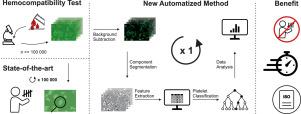Engineering Applications of Artificial Intelligence ( IF 7.5 ) Pub Date : 2020-11-06 , DOI: 10.1016/j.engappai.2020.104009 Johanna C. Clauser , Judith Maas , Jutta Arens , Thomas Schmitz-Rode , Ulrich Steinseifer , Benjamin Berkels

|
The hemocompatibility of blood-contacting medical devices remains one of the major challenges in biomedical engineering and makes research in the field of new and improved materials inevitable. However, current in-vitro test and analysis methods are still lacking standardization and comparability, which impedes advances in material design. For example, the optical platelet analysis of material in-vitro hemocompatibility tests is carried out manually or semi-manually by each research group individually.
As a step towards standardization, this paper proposes an automation approach for the optical platelet count and analysis. To this end, fluorescence images are segmented using Zach’s convexification of the multiphase-phase piecewise constant Mumford–Shah model. The non-background components then need to be classified as platelet or no platelet. For this purpose, a supervised random forest is applied to feature vectors derived from the components using features like area, perimeter and circularity. With an overall high accuracy ( 93 %) and low error rates ( 5 %), the random forest achieves reliable results. This is supported by high areas under the receiver–operator characteristic curve ( 0.94) and the prediction–recall curve ( 0.77), respectively.
We developed a novel method for a fast, user-independent and reproducible analysis of material hemocompatibility tests. The automatized analysis method overcomes the current obstacles in the way of standardized in-vitro material testing and is therefore a unique and powerful tool for advances in biomaterial research.
中文翻译:

使用图像分割和监督分类自动进行血液相容性分析
血液接触医疗设备的血液相容性仍然是生物医学工程中的主要挑战之一,这使得在新型和改良材料领域的研究成为必然。然而,当前的体外测试和分析方法仍缺乏标准化和可比性,这阻碍了材料设计的进步。例如,每个研究小组分别手动或半手动对材料进行体外血液相容性测试的光学血小板分析。
作为标准化的一步,本文提出了一种自动化的血小板计数和分析方法。为此,使用多相相位分段常数Mumford-Shah模型的Zach凸化对荧光图像进行分割。因此,非背景成分需要分类为血小板或无血小板。为此,将监督随机森林应用于使用诸如面积,周长和圆度之类的特征从组件派生的特征向量。具有较高的整体精度( 93%)和低错误率(5%),随机森林取得了可靠的结果。接收机-运营商特性曲线下的高区域对此提供了支持( 0.94)和预测召回曲线( 0.77)。
我们开发了一种新颖的方法,可对材料的血液相容性测试进行快速,独立于用户且可重复的分析。自动化分析方法克服了标准化体外材料测试方法中的当前障碍,因此是生物材料研究进展的独特而强大的工具。











































 京公网安备 11010802027423号
京公网安备 11010802027423号